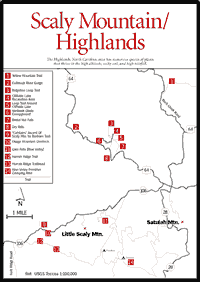 Highlands,
North Carolina
Highlands,
North Carolina  Highlands,
North Carolina
Highlands,
North Carolina
Central to this remarkable and highly scenic area is an unusually high (4,000-foot)
plateau on the southern edge of the Blue Ridge. Numerous mountains with steep
granite cliffs—a unique feature in the southern Appalachians—create
imposing scenery in this area. These cliffs may be seen from NC 106 and US 64
and, indeed, throughout the area; but they are best observed from the tops of
two remarkable mountains, Whiteside and Satulah. Both of these summits are reached
by short,
easy trails.
The cliffs and rock outcrops are botanical treasure houses showcasing the southernmost distribution of numerous rock-loving plants which need a combination of altitude, bare rock, and high rainfall to survive. These cliffs are excellent places to see peregrine falcons, ravens, and wintering golden eagles.
This region encompasses the headwaters of the famed Chattooga River and is the major northern access to the Ellicott Rock Wilderness. Streams such as the Cullasaja fall off the plateau in steep gorges. Waterfalls are frequent. Vistas of the Rabun Bald country and Blue Valley, now an experimental forest, are visible from NC 106, especially at the Osage Mountain [Fig. 49(10), Fig. 49(9)] and Blue Valley overlooks.
A short but narrow road leads to the summit, which is privately owned and affiliated with the Unitarian Church. It is an excellent example of a rock bald with an unusual forest of ancient, "krummholz" (wind-sheared) white oak, along with evergreen heath. This may be the oldest white oak stand in the world. Many trees have been dated between 400 and 500 years of age. A viewing tower is present. This is one of the very few instances in which one can drive to the summit of a granite dome.
The summit of Satulah (4,543 feet) is classified as a heath bald. From here the visitor can view the mountains of three states. Ascending the trail, one first encounters a forest comprised of northern red oak, white oak, and chestnut oak. At the first switchback there begins a remarkable stand of mountain pepperbush overhanging the trail. Both chinquapin and witch hazel are common shrubs here. Soon hikers pass into a stunted, virgin oak forest. At the trail fork, go right. As one approaches the summit, the forest becomes heath (rhododendron) with stunted white oak. At the summit are scattered, dwarfed white oak, some 200 years old.
This is a zone with dwarfed pitch pine where a 200-year-old tree may be only 10 inches in diameter. The first purple rhododendron is encountered along with the first pines. Chinquapin is abundant.
The summit provides the best look at unusual plants growing only on the bare granite rock so characteristic of the cliffs of this area and extending into Georgia only on similar cliffs along the Chattooga headwaters. One of the most fascinating, the twisted hair spike moss, forms large, thick mats on the upper cliffs. Another, sand myrtle, grows only at the outer edge of the ground cover extending onto the rocks. A rare juniper forms low-spreading, wind-pruned growth. Exploring the summit, one can find curious potholes, the basement of a former fire tower, and patches of soil forming in moist depressions in the naked rock. Often on other outcrops, the niche of the pitch pine is filled by the rarer table mountain pine, and hemlocks might include the rare Carolina hemlock. In the spring the evergreen heaths on these balds present unequalled wildflower displays. The mountain summit is protected and offered for public use and education by the Satulah Summit and Ravenel Park, Inc.
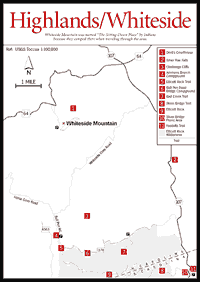 The
Highlands Nature Center
The
Highlands Nature Center The center offers daily programs for children and adults, including lectures, nature classes, tours of the botanical gardens, and outings. The center offers exhibits on local archeology, geology, and biology, including live salamanders, snakes, and fish. Fresh wildflower arrangements are available to help visitors identify local plants. Next door is the Appalachian Environmental Art Center, where one may enroll in classes in nature and landscape photography.
Founded in 1929, the Highlands Biological Station hosts about 20 scientists and students annually for research in the field of biology of the southern Appalachians. On 20 acres, it maintains a rhododendron trail as well as one of the finest wildflower "gardens" in the Appalachians. The garden is a series of loop trails through the forest, with plants labeled along the way.
This very scenic drive is a major entrance to the Ellicott Rock Wilderness from the north.
In Highlands, East Main Street becomes Horse Cove Road shortly before the Highlands Nature Center. Follow this winding paved road into beautiful Horse Cove. As one enters the cove, Rich Gap Road is on the right. Approximately 200 feet up Rich Gap Road on the right is the path to a giant poplar, the second largest in North Carolina and one of the three largest in the country. There is a direction sign to the tree. Back to Horse Cove Road, continue east to the fork at the end of the pavement. The right fork is Bull Pen Road, a beautiful, one-lane, gravel road that is something of a hiking trail for cars. Bull Pen Road crosses the Chattooga on an iron bridge. By the bridge is a good place to stop and view the river. The water has worn basins in the rocks from the size of a thumb print to larger than washtubs.
From Bull Pen Road there is access to Chattooga River Cliffs Trail [Fig. 50(3)], Chattooga Loop Trail, the Chattooga Wild and Scenic River, Bad Creek Trail, Ellicott Rock Trail [Fig. 48(1)], and Ammons Branch Campground [Fig. 48(2), Fig. 50(4)]. The road returns to NC 107 south of Cashiers.
The left fork from Horse Cove Road is Whiteside Cove Road. A fine view from the bottom of Whiteside Mountain can be found in Whiteside Cove. This road returns to NC 107 in Cashiers.
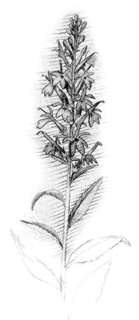 Cullasaja
River Gorge
Cullasaja
River Gorge [Fig. 49(2)] US 64 runs between Highlands and Franklin, North Carolina, following the gorge cut by the Cullasaja River through the granite gneiss mountain and passing a number of waterfalls and scenic areas.
BRIDAL VEIL FALLS. [Fig. 49(7)] This falls cascades from a height of 120 feet over the highway, 1.2 miles west of Highlands. Basswood and yellow birch trees, characteristic of northern hardwood forests, are found in the vicinity.
DRY FALLS. [Fig. 49(8)] 2.1 miles from Highlands. There is limited parking, and the short trail down the cliff to the 75-foot falls is well marked. Those who do not mind getting a bit wet can walk under the falls to view the gorge. Mountain laurel is abundant. In the area around both Bridal Veil and Dry falls, visitors will see Fraser magnolia, white pine, Eastern hemlock, and red maple, along with dog-hobble, rosebay rhododendron, and wild hydrangea. These falls nurture some extremely rare ferns.
LOWER CULLASAJA FALLS. Eight miles west of Highlands, this falls cascades about 250 feet. It is unmarked, but there is a pullover area in which to park and view the falls. The trees in this area include tulip poplar, yellow birch, red oak, and chestnut oak. Also present are grape, Virginia creeper, and wild hydrangea.
Trail guides, maps, brochures, and books about the area are available at the Forest Service's Highlands District Visitor Center in Wright Square near the intersection of US 64 and NC 106 in Highlands. Open May through November with limited hours in May and November. Similar information is available at the U.S. Forest Service District Office on Flat Mountain Road east of Highlands off US 64. The turnoff is well marked.
ELLICOTT ROCK TRAIL. [Fig. 48(1)] About 3.5 miles. One of the oldest trails in the area, Ellicott Rock Trail runs from the trailhead [Fig. 50(4)] to the surveyor's rock marking the intersection of Georgia, North Carolina, and South Carolina. It follows an old roadbed for over 2 miles, makes a left turn at a fork, and descends to the Chattooga River corridor. It then climbs steeply, crosses the Chattooga River, and joins the Chattooga River Trail and Bad Creek Trail. Ellicott Rock is downstream on the far bank, inscribed with a simple "NC" [Fig. 48(5)]. The rock that most people find is actually Commissioner's Rock—the true intersection of the three states. It is located 10 feet downstream from Ellicott Rock and inscribed "LAT 35 AD 1813 NC SC." Both rocks were named for surveyors who marked state boundaries. The return hike is more difficult than the hike in; the climb requires 2 hours or more.
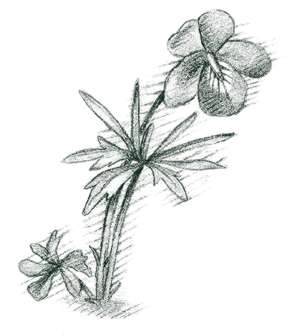 BAD
CREEK/FOWLER CREEK TRAIL. [Fig.
48(3)] Similar in terrain to the Ellicott Rock Trail (above). This
trail follows an old roadbed for about .75 mile to where an old road, now blocked
off, led down to Bad Creek. The main trail continues with gentle ascents and
descents for 1.5 miles, where it intersects the Sloan Bridge Trail. It then
continues down steeply, with switchbacks for 1.5 miles, to the river level.
Here it joins the Ellicott Rock Trail and Chattooga River Trail. Ellicott Rock
is .125 mile downstream.
BAD
CREEK/FOWLER CREEK TRAIL. [Fig.
48(3)] Similar in terrain to the Ellicott Rock Trail (above). This
trail follows an old roadbed for about .75 mile to where an old road, now blocked
off, led down to Bad Creek. The main trail continues with gentle ascents and
descents for 1.5 miles, where it intersects the Sloan Bridge Trail. It then
continues down steeply, with switchbacks for 1.5 miles, to the river level.
Here it joins the Ellicott Rock Trail and Chattooga River Trail. Ellicott Rock
is .125 mile downstream.
YELLOW MOUNTAIN TRAIL. [Fig. 49(1)] About 9.6 miles round-trip. The longest trail in the Highlands area leaves Cole Mountain Gap (4,300 feet) and traverses two peaks—Cole Mountain (4,600 feet) and Shortoff Mountain (5,000 feet)—and ends with a 360-degree panoramic view on Yellow Mountain (5,127 feet). The gneissic, oak ridge forest is dominated by white oak (formerly mixed with chestnut) with unusually abundant serviceberry as a subcanopy. Offering trailside snacks in late summer and fall are two abundant heaths, deerberry and buckberry. In April to June there are floral displays. Masses of hayscented and New York fern offer pleasing vistas.
GLEN FALLS (BLUE VALLEY). [Fig. 49(11)] A gravel, one-lane, Forest Service road approximately 1.5 miles southwest of Highlands on the south side of NC 106 leads to Glen Falls. Follow this road about a mile to the parking area and a sign for Glen Falls Scenic Area. It is a short, .5-mile walk to the falls. Glen Falls is a series of three falls, approximately 60 feet each, on the east fork of Overflow Creek. A steep, 1-mile trail with steps and places to rest along it goes down to the bottom of the falls, where the view is better. Be cautious, as the trail has washed away in some places. The trail continues down into Blue Valley Campground (primitive). Blueberries and rhododendron grow in the area. Glen Falls offers a magnificent vista over northeastern Georgia and northwestern South Carolina, the Chattooga River valley.
HURRAH RIDGE/WEST FORK LOOP TRAIL. About 1.5 miles long and fairly steep. In the Highlands/Cashiers area and eastward, corundrum deposits have yielded many sapphires of gem quality. One community near US 64 is, in fact, named Sapphire. Several old mines are quite close to the highway. This trail leads to the old Tiffany sapphire mine.
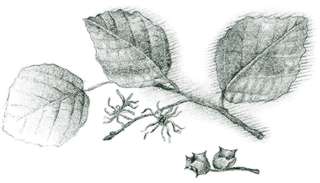 Whiteside
Mountain
Whiteside
Mountain [Fig. 50] Whiteside is an outstanding example of the isolated, cliff-sided mountains characteristic of the Highlands/Cashiers area. Its summit offers fine views from a high ridgetop amidst the beauty and solitude of the forest. To the north is Devil's Courthouse [Fig. 50(1)], a huge rock outcropping, and the headwaters of the Chattooga River. To the south are Whiteside Cove and a long view back into Georgia and South Carolina.
Whiteside Mountain is a magnificent and popular spot. Technical rock climbers test their skills here. The mountain was known by the Indians as "the sitting-down place" because they camped there when traveling through the area. Legend says that Spanish explorers also visited the mountain as they passed through this part of the country.
The U.S. Forest Service acquired Whiteside in 1974. The old road is now closed to motorized vehicles. The visitor can hike part or all of the 2-mile loop trail to the 4,930-foot summit for a view of the valley floor, lying 2,100 feet below the surrounding mountains. The Whiteside Mountain Trail is designated a National Recreation Trail and is a component of the National Trail System.
Both the north and south faces of Whiteside contain sheer cliffs ranging from 400 to 750 feet in height. These cliffs were formed from igneous rock commonly called "whiteside granite" (actually a quartz diorite gneiss). This rock contains a high content of feldspar, quartz, and mica, along with such minerals as pyrite and rare monazite. Due to the weathering and drying effects of wind and sunlight, the cliffs on the south side have little vegetation. Their blue-gray hue is the natural rock color. The very noticeable white streaks that decorate this side are veins of feldspar and quartz.
The north face, which receives less sunlight and more moisture, has a darker appearance due to the mosses and lichens that are able to grow in this more favorable environment.
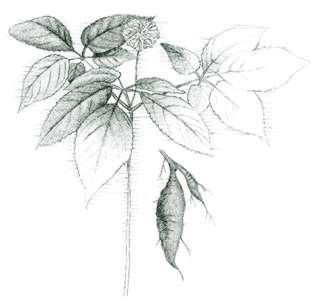 Two
distinct plant communities are present on Whiteside. First is the forest where
oaks—particularly northern red oaks—are dominant. Also commonly found
in the forest are Fraser magnolia, black birch, yellow birch, striped maple,
and witch hazel. Before the chestnut blight in the early 1900s destroyed all
of the large chestnut trees, there was a concentration of chestnut here.
Two
distinct plant communities are present on Whiteside. First is the forest where
oaks—particularly northern red oaks—are dominant. Also commonly found
in the forest are Fraser magnolia, black birch, yellow birch, striped maple,
and witch hazel. Before the chestnut blight in the early 1900s destroyed all
of the large chestnut trees, there was a concentration of chestnut here.
There is an abundance of chestnut sprouts in the area, but they seldom reach more than 3 inches in diameter before dying.
The second community exists in the rock outcrops along the cliffs' edges and along trails. An abundance of flowering and nonflowering plants and shrubs grows here—some rare, all beautiful. The common shrubs include rosebay rhododendron, mountain laurel, and flame azalea. Plants include false lily of the valley, several species of trillium, summer bluets, wild strawberry, sand myrtle, mats of spike moss on outcrops, and the rare Carolina hemlock.
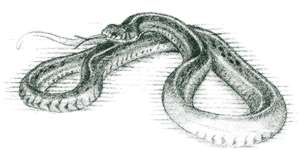 Campgrounds
and Recreations Areas
Campgrounds
and Recreations Areas BLUE VALLEY PRIMITIVE CAMPING AREA. [Fig. 49(14)] Go 6 miles south of Highlands on NC 28, turn right (west) on a road into Blue Valley and then go 3 miles. The campground is on the right. There is a pit toilet. The water supply is from streams and should be boiled or treated before using. This camp area is recommended for small groups.
VANHOOK GLADE CAMPGROUND. [Fig. 49(6)] About 4.3 miles west of Highlands (elevation 3,300 feet). The campground is open from about early April until late October, depending on the weather. Each of the 20 quiet, secluded, small campsites has a parking space, grill/fireplace, table, and tent pad. Small trailers will fit into some parking spaces; RVs are allowed. A volunteer host is on site to answer questions. No group larger than family-size is permitted to camp. There are five water spigots and a flush toilet. The area is 1.5 miles from Cliffside Lake by either road or trail. Campers have free access to Cliffside Lake Recreation Area, (below).
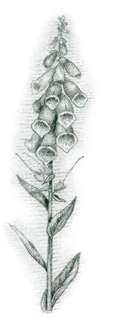 CLIFFSIDE
LAKE RECREATION AREA. [Fig.
49(4)] Located 4.4 miles west of Highlands and 1.5 miles off US 64, Cliffside
is open year-round as a day area but no water is available from the end of October
until early May. There are picnic tables and shelters, a bathhouse with cold
showers and flush toilets, and a cliff-top vista shelter. Cliffside Lake provides
good trout fishing and a swimming beach. There are six marked hiking trails
in the area ranging from .5 mile to 1.5 miles in length, including a loop trail
around the lake [Fig.
49(5)] and another longer loop [Fig. 49(3)] which includes the crest of
a nearby ridge. White pine and Eastern hemlock trees, rhododendron, blackberry,
and mountain laurel grow in the campground.
CLIFFSIDE
LAKE RECREATION AREA. [Fig.
49(4)] Located 4.4 miles west of Highlands and 1.5 miles off US 64, Cliffside
is open year-round as a day area but no water is available from the end of October
until early May. There are picnic tables and shelters, a bathhouse with cold
showers and flush toilets, and a cliff-top vista shelter. Cliffside Lake provides
good trout fishing and a swimming beach. There are six marked hiking trails
in the area ranging from .5 mile to 1.5 miles in length, including a loop trail
around the lake [Fig.
49(5)] and another longer loop [Fig. 49(3)] which includes the crest of
a nearby ridge. White pine and Eastern hemlock trees, rhododendron, blackberry,
and mountain laurel grow in the campground.
AMMONS BRANCH CAMPGROUND. [Fig. 48(2), Fig. 50(4)] Located on the right about 1.5 miles from the fork at the beginning of Bull Pen Road, marked with a Forest Service sign. This little-used, small campground may not be accessible by car after heavy rains. The only water supply is from streams and must be boiled or treated. There is one picnic table, a grill, and a pit toilet. A connector trail leaves from the campground, parallels Bull Pen Road, and joins the Ellicott Rock Trail about .2 mile from its head on Bull Pen Road, 1 mile west of the bridge. There is limited parking at the trailhead.
Map References: USGS 1:24,000 series: Highlands–Cashiers Sealy.
Read and add comments about this page